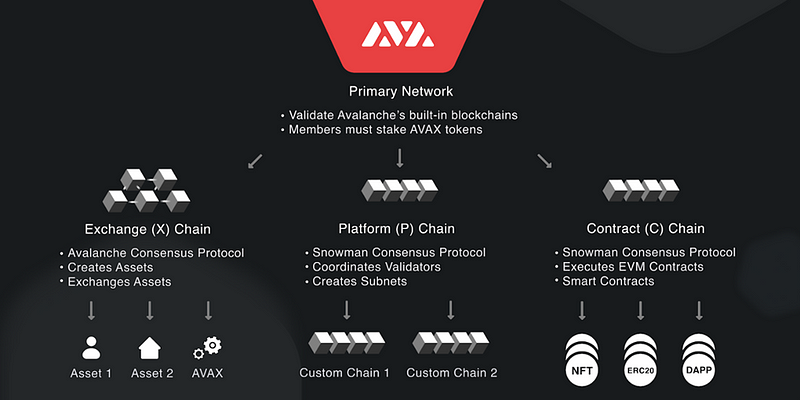Avalanche Blockchain’s Subnets: An In-Depth Look
One key feature that sets Avalanche apart from other blockchain platforms is its implementation of subnets, which enables the creation of…

One key feature that sets Avalanche apart from other blockchain platforms is its implementation of subnets, which enables the creation of tailored, interoperable networks to meet specific requirements.
In this article, we will delve into the low-level mechanics of Avalanche’s subnets.
Subnets, short for “subnetworks,” are separate, interoperable blockchains within the Avalanche ecosystem. Subnets allow developers to build customized networks tailored to their specific security, functionality, or governance needs.
Subnet Architecture: Validators, Chains, and Virtual Machines
At a low level, subnets have three main components: validators, chains, and virtual machines.
- Validators: Validators are nodes responsible for securing and maintaining the blockchain by participating in the consensus process. In Avalanche, each subnet has its own set of validators, which can be distinct from validators in other subnets. Validators can join or leave a subnet by staking the native AVAX token, with the minimum staking requirement determined by the subnet’s governance rules.
- Chains: Within a subnet, there can be multiple chains, each with unique functionality. A chain is a series of blocks containing a set of transactions. Depending on the desired functionality and capabilities, chains can be instantiated with different virtual machines.
- Virtual Machines: Virtual machines (VMs) are the runtime environments that execute smart contracts and transactions within a chain. Avalanche supports multiple VMs, allowing developers to choose the best-suited VM for their chain based on programming languages, execution models, and built-in features.
Interoperability: Cross-Subnet Communication
One of the critical features of Avalanche’s subnet architecture is its support for cross-subnet communication. Subnets in Avalanche can interact with each other seamlessly, enabling assets and data to be transferred between different chains and subnets. This interoperability is made possible by a native cross-chain communication protocol that facilitates atomic swaps and contract calls across subnets. The protocol ensures that transactions are executed successfully on all involved chains or fail altogether, maintaining consistency and security across the ecosystem.
Customizability: Creating Subnets with Unique Governance and Security Models
Avalanche subnets offer customizability, allowing developers to define their subnet’s unique governance and security models. When creating a subnet, developers can specify the following:
- Validator Set: Developers can choose the validators responsible for securing their subnet. They can also establish custom staking requirements, slashing conditions, and validator rewards, allowing for the creation of subnets with different security guarantees and economic incentives.
- Consensus Algorithm: Avalanche’s default consensus algorithm is the Avalanche Consensus Protocol (ACP), a highly scalable and secure consensus mechanism. However, developers can implement alternative consensus algorithms within their subnets, catering to specific requirements and use cases.
- Governance Rules: Subnets can have their governance rules, enabling developers to create networks with unique decision-making processes, upgrade policies, and access controls.
Dynamic Subnet Membership
Avalanche’s subnet architecture enables dynamic membership, allowing validators to join or leave subnets as needed. Validators can stake AVAX tokens to enter a subnet and participate in its consensus process, earning rewards. Conversely, validators can unstake their tokens and exit a subnet, freeing up resources to join other subnets or to secure their holdings. This dynamic membership model ensures that the Avalanche ecosystem remains adaptive, resilient, and capable of accommodating the changing needs of its diverse user base.
Use Cases for Avalanche Subnets
The flexibility and customizability offered by Avalanche subnets pave the way for a wide array of use cases, including:
- Industry-specific blockchains: Subnets can be tailored to cater to specific industries, such as supply chain management, finance, or healthcare, with chains and virtual machines optimized for the unique requirements of each sector.
- Regulatory compliance: Subnets can be designed to meet specific regulatory requirements, enabling the creation of legally compliant networks for different jurisdictions. For example, a subnet can enforce Know Your Customer (KYC) and Anti-Money Laundering (AML) rules, ensuring all participants adhere to the necessary regulations.
- Private and permissioned networks: Enterprises and consortiums can create private or permissioned subnets with access controls, allowing them to maintain privacy and control over their data and transactions while benefiting from Avalanche’s interoperable ecosystem.
- Experimental networks: Developers can leverage subnets to test new consensus algorithms, governance models, or virtual machines in a controlled environment before deploying them on a larger scale.
Avalanche’s subnet architecture unlocks an exciting level of flexibility and customizability in the blockchain space, enabling developers to create tailored networks that cater to specific requirements and use cases.
Stay tuned, and happy coding!
Visit my Blog for more articles, news, and software engineering stuff!
Follow me on Medium, LinkedIn, and Twitter.
Check out my most recent book — Application Security: A Quick Reference to the Building Blocks of Secure Software.
All the best,
Luis Soares
CTO | Head of Engineering | Blockchain Engineer | Web3 | Cyber Security | Golang & eBPF Enthusiast
#blockchain #avalanche #subnets #smartcontracts #network #datastructures #communication #protocol #consensus #protocols #data #smartcontracts #web3 #security #privacy #confidentiality #cryptography #softwareengineering #softwaredevelopment #coding #software



